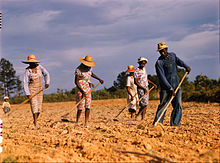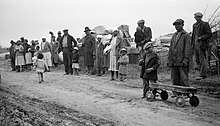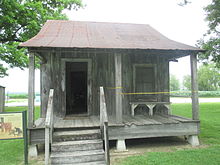Sharecropping
This article has multiple issues. Please help improve it or discuss these issues on the talk page. (Learn how and when to remove these template messages)
|
| Agriculture |
|---|
 |
|
|
Sharecropping is a legal arrangement in which a landowner allows a tenant to use the land in return for a share of the crops produced on that land.
Sharecropping has a long history and there are a wide range of different situations and types of agreements that have used a form of the system. Some are governed by tradition, and others by law. The
Overview

Under a sharecropping system, landowners provided a share of land to be worked by the sharecropper, and usually provided other necessities such as housing, tools, seed, or working animals.[1] Local merchants usually provide food and other supplies to the sharecropper on credit. In exchange for the land and supplies, the cropper would pay the owner a share of the crop at the end of the season, typically one-half to two-thirds. The cropper used his share to pay off their debt to the merchant.[2] If there was any cash left over, the cropper kept it—but if their share came to less than what they owed, they remained in debt.
A new system of credit, the crop lien, became closely associated with sharecropping. Under this system, a planter or merchant extended a line of credit to the sharecropper while taking the year's crop as collateral. The sharecropper could then draw food and supplies all year long. When the crop was harvested, the planter or merchants who held the lien sold the harvest for the sharecropper and settled the debt.
Sociologist Jeffery M. Paige made a distinction between centralized sharecropping found on cotton plantations and the decentralized sharecropping with other crops. The former is characterized by long lasting tenure. Tenants are tied to the landlord through the
Farmers who farmed land belonging to others but owned their own mule and plow were called tenant farmers; they owed the landowner a smaller share of their crops, as the landowner did not have to provide them with as much in the way of supplies.
Application by region
Historically, sharecropping occurred extensively in
Africa
In settler colonies of colonial Africa, sharecropping was a feature of the agricultural life. White farmers, who owned most of the land, were frequently unable to work the whole of their farm for lack of capital. They, therefore, had African farmers to work the excess on a sharecropping basis.
In South Africa the 1913
The arrangement has reappeared in other African countries in modern times, including Ghana[10] and Zimbabwe.[11]
Economic historian Pius S. Nyambara argued that Eurocentric historiographical devices such as "feudalism" or "slavery" often qualified by weak prefixes like "semi-" or "quasi-" are not helpful in understanding the antecedents and functions of sharecropping in Africa.[11]
United States

Prior to the Civil War, sharecropping is known to have existed in
After the war, plantations and other lands throughout the South were seized by the federal government. In January 1865, General William T. Sherman issued Special Field Orders No. 15, which announced that he would temporarily grant newly freed families 40 acres of this seized land on the islands and coastal regions of Georgia. Many believed that this policy would be extended to all formerly enslaved people and their families as repayment for their treatment at the end of the war. In the summer of 1865, President Andrew Johnson, as one of the first acts of Reconstruction, instead ordered all land under federal control be returned to the owners from whom it had been seized.

Southern landowners thus found themselves with a great deal of land but no liquid assets to pay for labor. They also maintained the "belief that gangs afforded the most efficient means of labor organization", something nearly all formerly enslaved people resisted. Preferring "to organize themselves into kin groups", as well as "minimize chances for white male-black female contact by removing their female kin from work environments supervised closely by whites", black southerners were "determined to resist the old slave ways".
American sharecroppers worked a section of the plantation independently, usually growing cotton, tobacco, rice, sugar, and other cash crops, and received half of the parcel's output.[19][20] Sharecroppers also often received their farming tools and all other goods from the landowner they were contracted with.[1] Landowners dictated decisions relating to the crop mix, and sharecroppers were often in agreements to sell their portion of the crop back to the landowner, thus being subjected to manipulated prices.[21] In addition to this, landowners, threatening to not renew the lease at the end of the growing season, were able to apply pressure to their tenants.[21] Sharecropping often proved economically problematic, as the landowners held significant economic control.[22]

In the Reconstruction Era, sharecropping was one of few options for penniless

Sharecropping continued to be a significant institution in many states for decades following the Civil War. By the early 1930s, there were 5.5 million white tenant farmers, sharecroppers, and mixed cropping/laborers in the United States; and 3 million Blacks.[24][25] In Tennessee, sharecroppers operated approximately one-third of all farm units in the state in the 1930s, with white people making up two thirds or more of the sharecroppers.[13] In Mississippi, by 1900, 36% of all white farmers were tenants or sharecroppers, while 85% of black farmers were.[12] In Georgia, fewer than 16,000 farms were operated by black owners in 1910, while, at the same time, African-Americans managed 106,738 farms as tenants.[26]
Around this time, sharecroppers began to form unions protesting against poor treatment, beginning in
About two-thirds of sharecroppers were white, the rest black. Sharecroppers, the poorest of the poor, organized for better conditions. The racially integrated Southern Tenant Farmers Union made gains for sharecroppers in the 1930s. Sharecropping had diminished in the 1940s due to the Great Depression, farm mechanization, and other factors.[32]
Impacts

Sharecropping was harmful to tenants with many cases of high interest rates, unpredictable harvests, and unscrupulous landlords and merchants often keeping tenant farm families severely indebted. The debt was often compounded year on year leaving the cropper vulnerable to intimidation and shortchanging.[33] Nevertheless, it appeared to be inevitable, with no serious alternative unless the croppers left agriculture.[34][35]
Landlords opt for sharecropping to avoid the administrative costs and
Some economists have argued that sharecropping is not as exploitative as it is often perceived. John Heath and Hans P. Binswanger write that "evidence from around the world suggests that sharecropping is often a way for differently endowed enterprises to pool resources to mutual benefit, overcoming credit restraints and helping to manage risk."[37]
Sharecropping agreements can be made fairly, as a form of
- Workers can rent plots of land from the owner for a certain sum and keep the whole crop.
- Workers work on the land and earn a fixed wage from the land owner but keep some of the crop.
- No money changes hands but the worker and land owner each keep a share of the crop.
According to sociologist Edward Royce, "adherents of the neoclassical approach" argued that sharecropping incentivized laborers by giving them a vested interest in the crop. American plantations were wary of this interest, as they felt that would lead to African Americans demanding rights of partnership. Many black laborers denied the unilateral authority that landowners hoped to achieve, further complicating relations between landowners and sharecroppers.[21]
Sharecropping may allow women to have access to arable land, albeit not as owners, in places where ownership rights are vested only in men.[39]
He also showed that in the presence of transaction costs, share-contracting may be preferred to either wage contracts or rent contracts—due to the mitigation of labor shirking and the provision of risk sharing. Joseph Stiglitz (1974,[43] 1988),[44] suggested that if share tenancy is only a labor contract, then it is only pairwise-efficient and that land-to-the-tiller reform would improve social efficiency by removing the necessity for labor contracts in the first place.
Reid (1973),[45] Murrel (1983),[46] Roumasset (1995)[47] and Allen and Lueck (2004)[48] provided transaction cost theories of share-contracting, wherein tenancy is more of a partnership than a labor contract and both landlord and tenant provide multiple inputs. It has also been argued that the sharecropping institution can be explained by factors such as informational asymmetry (Hallagan, 1978;[49] Allen, 1982;[50] Muthoo, 1998),[51] moral hazard (Reid, 1976;[52] Eswaran and Kotwal, 1985;[53] Ghatak and Pandey, 2000),[54] intertemporal discounting (Roy and Serfes, 2001),[55] price fluctuations (Sen, 2011)[56] or limited liability (Shetty, 1988;[57] Basu, 1992;[58] Sengupta, 1997;[59] Ray and Singh, 2001).[60]
See also
- Coolie
- Convict lease
- Peonage
- Rent-seeking
- Rural tenancy
- Sharefarming
- Sharemilking
- Tenant farmer
- Wage slavery
References
- ^ a b Mandle, Jay R. Not Slave, Not Free: The African American Economic Experience Since the Civil War. Duke University Press, 1992, 22.
- ^ a b Ronald L. F. Davis "The U. S. Army and the Origins of Sharecropping in the Natchez District—A Case Study" The Journal of Negro History, Vol. 62, No.1 (January 1977), pp. 60–80 in JSTOR
- ^ Jeffery Paige, Agrarian Revolution, page 373
- ^ Griffiths, Liz Farming to Halves: A New Perspective on an Absurd and Miserable System in Rural History Today, Issue 6:2004 p.5, accessed at British Agricultural History Society, 16 February 2013.
- ^ a b Joseph D. Reid, "Sharecropping as an understandable market response: The postbellum South." Journal of Economic History (1973) 33#1 pp. 106–130. in JSTOR
- ^ Sanval, Nasim; Steven, Helfand (2016-01-15). Optimal groundwater management in Pakistan's Indus Water Basin. Intl Food Policy Res Inst.
- S2CID 154416728.
- ISBN 978-1-135-78003-6.
- ^ "The Native Land Act is passed | South African History Online". Sahistory.org.za. Archived from the original on 14 October 2010. Retrieved 22 October 2023.
- ^ Leonard, R. and Longbottom, J., Land Tenure Lexicon: A glossary of terms from English and French speaking West Africa[permanent dead link] International Institute for Environment and Development (IIED), London, 2000
- ^ a b Pius S. Nyambara (2003). "Rural Landlords, Rural Tenants, and the Sharecropping Complex in Gokwe, Northwestern Zimbabwe, 1980s–2002" (PDF). Archived from the original (PDF) on 2006-03-26. Retrieved 2006-05-18., Centre for Applied Social Sciences, University of Zimbabwe and Land Tenure Center, University of Wisconsin–Madison, March 2003 (200Kb PDF)
- ^ a b Charles Bolton, "Farmers Without Land: The Plight of White Tenant Farmers and Sharecroppers Archived 2016-03-04 at the Wayback Machine", Mississippi History Now, March 2004.
- ^ a b c Robert Tracy McKenzie, "Sharecropping", Tennessee Encyclopedia of History and Culture.
- ISBN 9781107036789.
- ^ Ronald L. F. Davis "The U. S. Army and the Origins of Sharecropping in the Natchez District—A Case Study" The Journal of Negro History, Vol. 62, No.1 (January, 1977), pp. 60–80 in JSTOR
- ^ Jones, Jaqueline. Labor of Love, Labor of Sorrow: Black Women, Work, and the Family from Slavery to the Present. Basic Books, 1985.
- ^ Eva O'Donovan, Becoming Free in the Cotton South (2007); Gavin Wright, Old South, New South: Revolutions in the Southern Economy Since the Civil War (1986); Roger L. Ransom and David Beckham, One Kind of Freedom: The Economic Consequences of Emancipation (2nd ed. 2008)
- ^ a b Gregorie, Anne King (1954). History of Sumter County, South Carolina, p. 274. Library Board of Sumter County.
- ISBN 0-8071-1941-5.
- ^ F. N. Boney (2004-02-06). "Poor Whites". The New Georgia Encyclopedia. Archived from the original on 2012-08-29. Retrieved 2006-05-18.
- ^ JSTOR j.ctt14bt3nz.9.
- ^ Ransom, Roger L., and Richard Sutch. One Kind of Freedom: The Economic Consequences of Emancipation. 2nd edition. Cambridge England ; New York: Cambridge University Press, 2001, 149.
- ISBN 9780820317526.
- ^ The Rockabilly Legends; They Called It Rockabilly Long Before they Called It Rock and Roll by Jerry Naylor and Steve Halliday DVD
- ISBN 978-0-306-80743-5
- ^ Geisen, James C. (January 26, 2007). "Sharecropping". New Georgia Encyclopedia. Retrieved April 23, 2019.
- ^ The Devil's Music: A History of the Blues
By Giles Oakley
Edition: 2. Da Capo Press, 1997, p. 185.
ISBN 978-0-306-80743-5
- ISBN 978-0-8078-9817-8
- ^ "California Newsreel - Film and Video for Social Change Since 1968". Newsreel.org. Retrieved 22 October 2023.
- ^ Charlie Barnet - Sharecropper's Blues. YouTube. 26 August 2011. Archived from the original on 2021-11-09.
- ^ Gordon Marshall, "Sharecropping," Encyclopedia.com, 1998.
- ^ "Sharecropping". Slavery by Another Name. PBS. Retrieved 7 December 2021.
- ^ "Sharecropping | Slavery By Another Name Bento | PBS". Sharecropping | Slavery By Another Name Bento | PBS.
- ISBN 9780817350383.
- ISBN 9781604731866.
- ^ Sharecropping and Sharecroppers, T J Byres
- ^
Heath, John & Binswanger, Hans P. (October 1998). "Chapter 3: Policy-Induced Effects of Natural Resource Degradation: The Case of Colombia" (PDF). In Lutz, Ernest (ed.). Agriculture and the Environment: Perspectives on Sustainable Rural Development. ISBN 0-8213-4249-5. Retrieved 2011-04-01.
- ^ Arthur F. Raper and Ira De A. Reid, Sharecroppers All (1941); Gavin Wright, Old South, New South: Revolutions in the Southern Economy since the Civil War (1986).
- ^ Bruce, John W.- Country Profiles of Land Tenure: Africa, 1996 (Lesotho, p. 221) Research Paper No. 130, December 1998, Land Tenure Center, University of Wisconsin-Madison accessed at UMN.edu Archived 2001-11-25 at the Wayback Machine June 19, 2006
- ^ Alfred Marshall (1920). Principles of Economics (8th ed.). London: Macmillan and Co., Ltd.
- S2CID 154860968. Retrieved 2009-06-14.
- JSTOR 1239911.
- JSTOR 2296714.
- ^ Stiglitz, Joseph (1988). "Principal And Agent". Princeton, Woodrow Wilson School – Discussion Paper (12). Retrieved 2009-06-14.
- S2CID 155056632.
- JSTOR 3003555.
- .
- ISBN 9780262511858.
- JSTOR 3003586.
- JSTOR 3003473.
- .
- S2CID 154402121.
- JSTOR 1814805.
- .
- .
- S2CID 191253.
- .
- .
- .
- .
Further reading
- Adams, Jane; Gorton, D. (2009). "This Land Ain't My Land: The Eviction of Sharecroppers by the Farm Security Administration". Agricultural History. 83 (3): 323–51. .
- Agee, James; Evans, Walker (1941). Let Us Now Praise Famous Men: Three Tenant Families. Boston: Houghton Mifflin.
- Allen, D. W.; Lueck, D. (1992). "Contract Choice in Modern Agriculture: Cash Rent versus Cropshare". Journal of Law and Economics. 35 (2): 397–426. S2CID 153707520.
- Barbagallo, Tricia (June 1, 2005). "Black Beach: The Mucklands of Canastota, New York" (PDF). Archived from the original (PDF) on November 13, 2013. Retrieved 2008-06-04.
- Davis, Ronald L. F. (1982). Good and Faithful Labor: From Slavery to Sharecropping in the Natchez District, 1860–1890. Westport, Connecticut: Greenwood Press. ISBN 0-313-23134-6.
- Ferleger, Louis (1993). "Sharecropping Contracts in the Late-Nineteenth-Century South". Agricultural History. 67 (3): 31–46. JSTOR 3744228.
- Garrett, Martin A.; Xu, Zhenhui (2003). "The Efficiency of Sharecropping: Evidence from the Postbellum South". Southern Economic Journal. 69 (3): 578–595. .
- Grubbs, Donald H. (1971). Cry from the Cotton: The Southern Tenant Farmer's Union and the New Deal. University of North Carolina Press. ISBN 0-8078-1156-4.
- Hurt, R. Douglas Hurt (2003). African American Life in the Rural South, 1900–1950. University of Missouri Press. ISBN 0-8262-1471-1.
- Liebowitz, Jonathan J. (1989). "Tenants, Sharecroppers, and the French Agricultural Depression of the Late Nineteenth Century". Journal of Interdisciplinary History. 19 (3): 429–445. JSTOR 204363.
- Reid, Joseph D. Jr. (1975). "Sharecropping in History and Theory". Agricultural History. 49 (2): 426–440. JSTOR 3741281.
- Roll, Jarod (March 16, 2010). "Out Yonder on the Road": Working Class Self-Representation and the 1939 Roadside Demonstration in Southeast Missouri". Southern Spaces. Archived from the original on January 10, 2011.
- Shaban, R. A. (1987). "Testing Between Competing Models of Sharecropping". Journal of Political Economy. 95 (5): 893–920. S2CID 55141070.
- Singh, N. (1989). "Theories of Sharecropping". In Bardhan, P. (ed.). The Economic Theory of Agrarian Institutions. Clarendon Press. pp. 33–72. ISBN 0-19-828619-8.
- Southworth, Caleb (2002). "Aid to Sharecroppers: How Agrarian Class Structure and Tenant-Farmer Politics Influenced Federal Relief in the South, 1933–1935". Social Science History. 26 (1): 33–70.
- Stiglitz, J. (1974). "Incentives and Risk Sharing in Share Cropping" (PDF). Review of Economic Studies. 41 (2): 219–255. JSTOR 2296714.
- Turner, Howard A. (1937). "Farm Tenancy Distribution and Trends in the United States". Law and Contemporary Problems. 4 (4): 424–433. JSTOR 1189524.
- Virts, Nancy (1991). "The Efficiency of Southern Tenant Plantations, 1900–1945". Journal of Economic History. 51 (2): 385–395. S2CID 154991172.
- Wayne, Michael (1983). The Reshaping of Plantation Society: The Natchez District, 1860–1880. Baton Rouge, Louisiana: Louisiana State University Press. ISBN 0-8071-1050-7.
External links
 Media related to Sharecropping at Wikimedia Commons
Media related to Sharecropping at Wikimedia Commons- King Cotton's Slaves, 1936 newsreel by The March of Time about landless Southern farmers
